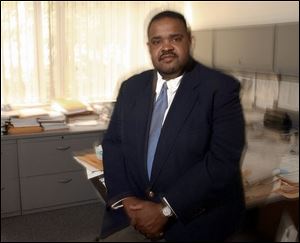
Lucas County job program isn't working
10/13/2002
Angelic Garcia's experiences finally caused her to give up on program.
blade
Laid off from her $15.55-an-hour job at Jeep, Angelic Garcia thought a special government program would help her find a new career.
Instead, the mother of three said it led to months of frustration that ultimately caused her to drop out of the job-training program.
“I put everything I had into doing that, and it backfired in my face,” she said.
Two years into the Lucas County program to help people get good jobs, Ms. Garcia isn't the only one frustrated.
County officials concede the Workforce Development initiative isn't working the way it's supposed to. A lack of caseworkers forces some people to wait months for particular training. If that's not bad enough, the county program this fall had to give back $555,000 - 10 percent of its first batch of federal aid - because it didn't spend it in time.
Some of that money could have been used to alleviate the bureaucratic logjam.
Beyond that, an investigation of the program by The Blade shows that:
Had they known differently, they say they could have spent it in time.
Partly as a result, the county still lacks a definite plan for a true “one-stop shop,” where anybody seeking a job can contact numerous public and private social-service agencies, as envisioned by federal law.
Even now, the state is still fighting with the federal government over the rules. So if Lucas County can work out the kinks in its program, it's unclear if it will have to be revamped under new regulations.
More than an embarrassment for county officials, the job-training program's woes have become a key campaign issue in the hottest local race this fall - for a county commissioner's seat. Challenger Maggie Thurber blames the problems on incumbent Sandy Isenberg, who has presided over the commissioners' board for 10 years.
Such accusations have led to an ongoing debate about just how bad the county's job-training program is.
Many of the program's clients have few complaints about the system, and county officials insist any problems are just growing pains made worse by a bad economy and poor advice from state and federal regulators.
“Everybody's focusing on the glass being half-empty, and I would focus on the glass being half-full,” Ms. Isenberg said.
But others consider the problems severe. Those include Robert Sweeney, who ran a nonprofit group, Private Industry Collaborative, that historically handled job training in Lucas County. He has asked the federal and state governments to do a complete audit of the county's program.
“In Lucas County, it's been an absolute disaster,” Mr. Sweeney said. “They've crawled back to Square Zero so many times. They don't even get to Square One.”

Gerald Shaffer works on Nykeshia Witcher's hair, left, and Les Levesque trims William Gaston at Herron's Beauty College, where both barbers are taking training.
Les Levesque was laid off from a job repairing computers. Gerald Shaffer couldn't find a job after moving back home from Columbus.
Short on cash, they turned to the job-training center and - after a couple months of testing, workshops, and waiting - caseworkers decided they qualified for free federal aid to attend barber school this fall.
“It was an answered prayer for me,” Mr. Levesque said.
These are the kind of success stories county officials like to tout about a program with one clear goal: Get people to work.
On the simple side of the equation, the program teaches things like how to write a resume and how to dress for work. For those with a harder time, it can offer extra help, anything from anger-management classes to math tutoring.
And for those who still can't get a good job, there are vouchers for extra schooling - anything from truck-driving school to Owens Community College.
So far, 4,100 people have taken part in the program - and 540 have gone on to extra schooling, getting about $2,500 on average.
But those lucky enough to qualify for extra schooling may have to deal with a bureaucratic logjam.
County officials concede it can take a month, sometimes longer, to get an appointment with a caseworker who can approve extra schooling. And often caseworkers want to see someone a second time, which can take another month to schedule.
That's just bad public policy to people like Pete Gerken, a Toledo city councilman who runs the UAW-DaimlerChrysler Ohio Training Center.
The center contracts with the county to help with basic retraining skills. Mr. Gerken has repeatedly complained to top county officials about the long wait for appointments.
“You have to remember these [laid-off workers] are a fairly fragile population, coming out of industrial jobs, who may be afraid to go to school as adult learners,” Mr. Gerken said. “If you keep putting hurdles in front of them, especially time hurdles, you're going to lose them.”
Ms. Garcia said she had one too many hurdles.
She was set to go back to school to become a medical office worker. She even waited her turn for approval from a county caseworker, and the OK led her husband to rearrange his work schedule.
But then the county told her she needed to take another test, and then told her she needed tutoring and would have to wait another four months to go to school. That was enough for her.
“You change your whole life around for this, only to be let down,” she said.

Walker: he heads the county job training effort.
The man in charge of the county job-training program, Eric Walker, said he was unfamiliar with that case.
But he's familiar with the staff shortage. There's just 10 job-training caseworkers, and only three of them are qualified to sign off on specialty schooling. Mr. Walker has repeatedly asked county officials for more caseworkers. So has his boss, Wayman Usher, head of the county's economic and workforce development.
“When you've got three of them to handle the entire county, that's nuts,” Mr. Usher said. “That's failure from Day One.”
With the ongoing reorganization of the county's mammoth welfare agency - Job and Family Services - Mr. Ciecka said he didn't want to hire new employees for job training, only to have to lay off other welfare employees under a downsizing.
The irony was that some of the money returned to the state this year could have been used to hire job-training caseworkers to reduce the backlog.
If extra people had been hired, Mr. Walker said, “we wouldn't be sitting here talking about a case of lapsed funding.”
For two decades, local job training was done by Mr. Sweeney's group, then known as the Private Industry Council. The federal and state governments directly contracted with the nonprofit, known by its acronym PIC, and the county had little say over what PIC did.
PIC's work wasn't without controversy. In the 1990s, critics decried how PIC officials partly used government funding to fly to Europe and dine at fancy restaurants, at the same time failing to keep proper records and losing track of clients.
PIC's critics got their chance to change the local system after Congress passed the Workforce Investment Act in 1998.
Under the act, the federal government turned over the cash to the states, starting in July, 2000. Ohio, in turn, turned over the cash to county governments. Lucas County officials had the choice of turning the job back to PIC, but decided to do it themselves.
In April, 2000 - three months before gaining control of the first $5 million batch of job-training money - county officials hired Mr. Walker, a former PIC middle manager, to oversee the new program.
Those seeking jobs were directed to the state unemployment office at 5454 Airport Hwy., where the state gave space to the county. The county stationed its job-training caseworkers there - less than half the number employed by PIC to do the same job.
At the time, county officials were preoccupied with streamlining their welfare agency. They also had to find a way to spend another pot of welfare grant money - $12 million - within 18 months or lose it.
“We were under pressure to spend that money, and we thought we had more time to spend the [job-training] grant,” Mr. Ciecka said.
Most people agree the county started too late with little administrative push to meet the deadline. That includes Tom Hayes, who oversees Ohio's Job and Family Services agency.
“Lucas County was slower than most [urban counties] to get the program going,” he said. “And I think it just got caught up in the mix of all the other activities and things going on.”
Mr. Sweeney, the former PIC director, alleges other problems, ranging from improperly bid contracts to poor performance by contracted agencies. He said the county shunned PIC's advice and said Mr. Walker is unqualified to run the program.
“At every turn, they reinvented the wheel. The problem is, their wheel has a lot of broken spokes and flat spots because they don't have the core competency to run the program,” he said. “The loss of the $550,000 shows that.”
County officials counter that they've garnered relatively clean state audits, and that Mr. Sweeney is unqualified to criticize.
They say he ran PIC only this last year, and his organization didn't qualify for any job-training money. It did get county money from pots of federal welfare aid, but PIC returned a fourth of the $1.7 million in grants - the same bureaucratic sin for which he's now chastising the county.
“Mr. Sweeney's negativity is based on his inability to write successful grant proposals,” Mr. Walker said.
Mr. Sweeney counters that county mismanagement was to blame for the problems with contracts sought or won by his agency. Regardless, he said the debate shouldn't be about PIC anymore.
“Whether or not PIC stays in business is not important,” he said. “What's really important is that people are not getting services.”
At a press conference in January, state administrators received a tongue-lashing from Ms. Isenberg, a Democrat.
The federal government had just told the Republican-controlled state government that it was doing a bad job of running the job-training program - so bad it appeared the state would have to return much of its job-training aid.
“There's absolutely no excuse for it,” Ms. Isenberg said at the time.
Half a year later, it's her county that's had to return money.
Federal regulations have always called for localities to spend their money within two years - so states can redistribute it to other localities that need it.
But local officials insist that state regulators originally told them they had three years.
Still, the two-year window shouldn't have come as a shock to county officials.
In December, 2001, state officials sent routine letters to officials at the county Job and Family Services department reminding them they had to spend of the first batch of job-training aid by June 30 of this year.
Ron Weber, a fiscal officer for the county office, said he believes he told Mr. Walker about the deadline. But Mr. Walker and Mr. Usher said they got no such word.
The county had a second chance earlier this year. A January warning letter - addressed to Ms. Isenberg from the state - was opened in the commissioners' office in Government Center. It found its way to Mr. Ciecka, who said he never passed it on because he erroneously assumed Mr. Walker and Mr. Usher had received a copy.
Then came a third chance - another warning letter from the state in February to all three county commissioners. Mr. Ciecka said this time he forwarded the letter to Mr. Usher's Maumee office, albeit in March. But Mr. Usher said he didn't receive it.
The fourth chance came in April, when the state sent yet another letter reminding officials at the county's Job and Family Services of the use-it-or-lose-it rule. Mr. Weber said he believes that sentiment was again shared with job-training officials, but - again - the job-training officials say they never got word.
Mr. Walker said he had heard rumors as early as last fall that there was a two-year window, but they were never told they'd lose the money for sure until June 21 - nine days before it all had to be spent.
They couldn't do it, and the state ended up taking back $555,517 of the original $5 million grant. Lucas County wasn't unique, but it had the second highest amount returned, behind $1.2 million in Hamilton County.
Regardless, Lucas County had to cut programs that were to be funded this fall with that money. Oregon schools had to reduce its program from 180 clients to just 100. The University of Toledo had to cut from 200 clients to 100.
County officials insist they'll spend all of the remaining job-training grant money - $5 million given to the county in July, 2001, and an additional $4.5 million given this July.
As for the snafu, they collectively share the blame.
Mr. Ciecka said he faults himself for not ensuring the messages got through. Commissioner Harry Barlos - the commissioner with unofficial oversight of the job-training programs - blames Mr. Walker, Mr. Usher, and himself.
Councilman Gerken blames Mr. Ciecka and says the issue should not be used to damage Ms. Isenberg's re-election bid.
Ms. Isenberg won't blame any of her staff. She said the responsibility ultimately rests with the three commissioners - herself included - who must oversee the programs.
“The buck stops at our desks,” she said.
Bill Brennan can see it now - a true “one-stop shop.”
Job seekers and small business owners converge in a campus staffed with a host of public and private agencies. The agencies work with job seekers to figure out how best to make them employable, while working with businesses to figure out the best way to get good workers.
Federal job-training aid would only be part of the funding. Money would roll in from private foundations and local businesses.
But Mr. Brennan, who chairs the county's voluntary advisory committee for job training, knows it may just be a dream.
“I don't know that we're ever going to have the money,” he said.
That's not the only problem.
Former chairman Tom Herman said there's really no agreement on what should be done - particularly among the county commissioners, who have the final say on anything.
“Pretty much I felt like a lame duck up there,” he said.
“The business community is frustrated to the point that something needs to happen now,” Mr. Herman said.
Mr. Barlos shares the frustration. He has long stumped about the importance of workforce development, but said the issue has continued to stagnate. He wants a summit of all the area's major government, business, and education players to reach a consensus.
“Workforce investment is the most critical issue facing this community,” he said.
And time is running out.
The county calls its current workshop for job training a “one-stop shop,” but only the state and the county are there. Clients are often referred to other places to get help.
The state Job and Family Services pays the rent, answers the phones, and mans the front counter, but it plans to close offices across the state next year in an effort to shift the lead to counties.
The county plans to hire some group to oversee a one-stop shop, but so far there's no definite timetable to do it.
Then again, there may be some new direction from the federal government. Officials with the U.S. Department of Labor, who oversee the job-training money for Ohio, have long complained about how Ohio has given nearly direct control of the money to any county of any size. Traditionally, only bigger counties - even bigger than Lucas - are allowed to go their own way.
“The state is going to have a really hard time figuring out whether to reel in these programs or not,” he said.
And then it may mean Lucas County will have to partner with a neighboring county to form or find a nonprofit group to do job-training, sort of like what PIC did.
“Here you've got this other unknown factor looming out there,” Mr. Usher said. “Nobody knows.”